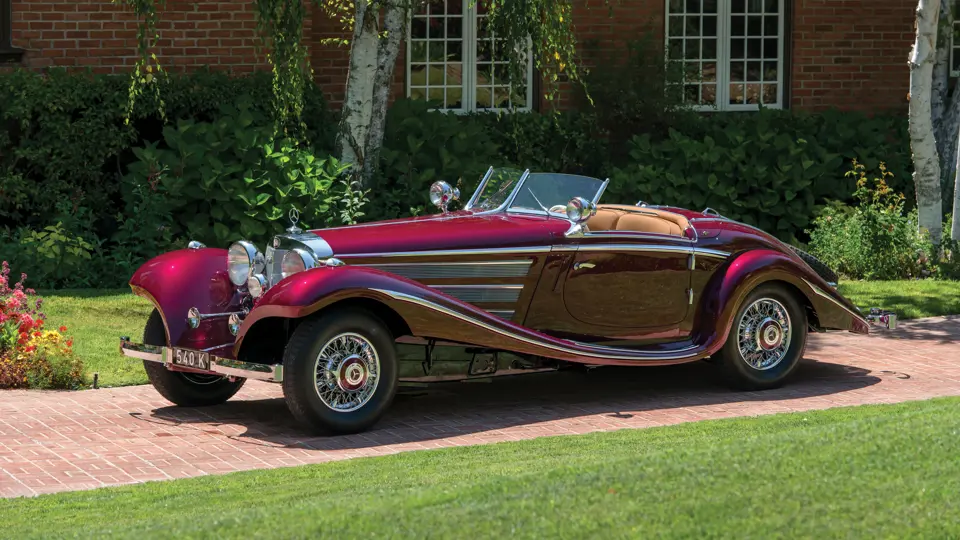For sheer beauty combined with outstanding performance, nothing compares with the Mercedes-Benz 500K and 540K supercars of the 1930s. Chief among these, certainly, is the 540K Special Roadster.
The 500K and 540K were the work of engineer Hans Nibel. Born in Bohemia in 1880, Nibel studied at Munich Technical College and joined Benz & Cie in 1904, becoming chief engineer four years later. It was he who championed shaft drive and created the Blitzen Benz speed record car of 1910. He was responsible for the powerful pre-World War I touring cars and for the postwar sports models, but after the merger he kept a lower profile until he was named technical director following Porsche’s departure in 1929. Throughout the period, however, he concentrated on advanced chassis engineering that became the mainstay of Mercedes-Benz in the 1930s.
For the new cars, Nibel came up with a straight-eight, a pushrod ohv design of 3,823-cc. The new Typ 380 had all-independent suspension, which Nibel had pioneered on the plebeian Typ 170 sedan. A double-wishbone design with coil springs was used in front, with coil-sprung swing axles at the rear. The 380, however, proved to be somewhat underpowered, making 90-hp when normally aspirated, 140-hp with the double-vane Roots-type supercharger, a bit underwhelming for a two-ton car. Nibel then came up with a larger 5-liter engine giving 100/160-hp, introduced in 1934 as the Typ 500K, “K” in this case meaning kompressor or supercharger. The wheelbase was extended to 3,290-mm (129.5-inches), and a range of cabriolets, roadsters and sedans was offered. Production of 500Ks totaled 354 over three years, followed by a further 419 540Ks with a larger, 5,401-cc engine. The larger powerplant was fitted with the same type Roots supercharger. This engaged at full throttle, raising horsepower from 115 to 180, or could be manually applied at part throttle if desired.
Nibel’s magic with the engine brought results. The Autocar tested a 500K and clocked a 0- to 60-mph time of 16.5 seconds (remarkable for the mid-1930s) and a top speed of 100-mph, the blower letting out “its almost demoniacal howl” when it was engaged. Motor enthused “here is a massive ‘unbreakable’ car capable of traveling indefinitely at high speed.” Another reporter cited the “sheer insolence of its power.”
Factory coachwork from the Daimler-Benz works at Singelfingen came in many variations. Styled and engineered by Hermann Ahrens, these svelte creatures display an unusual degree of élan for manufacturer-produced bodies. Built on the short, 2,980-mm (117.3-inch) wheelbase, the Cabriolet A was a two-passenger drophead coupe, of which 83 were built. Cabriolets B and C were four-seaters of “four-window” and “two-window” configuration, respectively, both on the “normal” 3,290-mm (129.5-inch) wheelbase. A long wheelbase, 3,880-mm (152.8-inches), was reserved for an even dozen convertible saloons.
Taking proportions to the extreme, Ahrens also created a two-passenger roadster on the normal chassis. With room to spare, the radiator was moved back 185-mm, and everything behind it the same distance. This variation was called fahrgestell mit zurückgesetztem (chassis with setback) and gave the car a completely different air, looking lower and longer. Called “Special Roadster,” just 25 were built.
This car was originally built as a 540K Cabriolet B. The current owner purchased it from a collector and broker of high-quality European cars in Los Angeles. He had reportedly acquired it from the estate of Dr. George Bitgood, a Middletown, Connecticut veterinarian. Fondly revered in his locale as “the vet of last resort,” Dr. Bitgood also had international renown as a collector of prewar Mercedes-Benz supercharged automobiles. Among them were Jack Warner’s 1937 540K Special Roadster, purchased from Dr. Sam Scher, and Hermann Göring’s Special Roadster, the “Blue Goose,” which he acquired from the Tunick brothers, plus another dozen noteworthy specimens.
As purchased, the car was in considerable disrepair, particularly the body, which needed to be rebuilt. As the Cabriolet B shared the chassis, drivetrain, lights, wire wheels and instruments of the Special Roadster, the new owner decided to rebody it as in that manner.
For this, he selected Cass Nawrocki of Moose Lake, Minnesota, who is well-known for outstanding coachwork and metalworking. Nawrocki had completely rebodied an original 540K Special Roadster and had patterns and jigs to create another body. He also had the rusted original fenders, doors and body parts from that rebodied Special Roadster to use for reference. A former employee of the late Tom Kried, Nawrocki wrote the definitive book on bodywork, Any Impossibility in Shaping Metal. For the new project he built a new wooden structure of kiln-dried eastern ash, then painstakingly created new exterior panels and affixed them to the wood frame. The process took two years in all, and is referenced in Nawrocki’s book.
The new body was then taken to Jim Friswold, the well-known Mercedes restorer in Portland, Oregon. Friswold had completed a superb Cabriolet A that had scored 100 points at Pebble Beach. No expense was spared in recreating this masterpiece, which took another three years. On its first time out, the car was rewarded with Best of Show at the Forest Grove Concours d’Elegance in Portland, Oregon. During the past year, it won the Most Glamorous Car award at the Niello Concours at Serrano in El Dorado Hills, California.
Painted in a metallic wine red that replicates Mercedes’ color of the period, this car is nothing less than stunning. Its condition, of course, is virtually new. Thus all brightwork is of the highest quality, as is the luscious tan leather interior. A brown canvas top snaps into place, like an original, should bad weather force the occupants to take cover. The foregoing list of awards speaks to the overall quality.
Mercedes-Benz 540K Special Roadsters seldom appear on the market in any form. This car thus represents a very special opportunity.



 | Santa Monica, California
| Santa Monica, California


